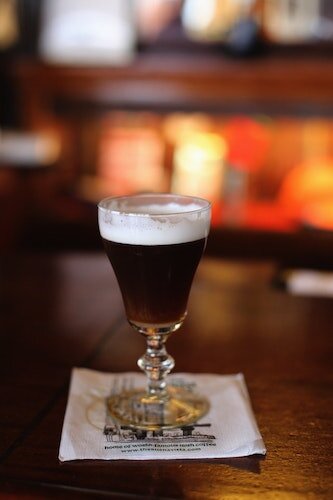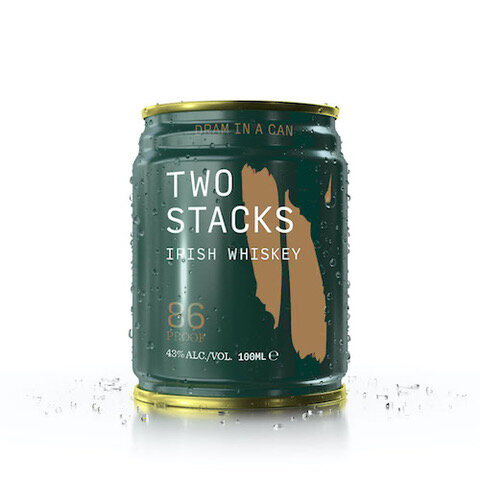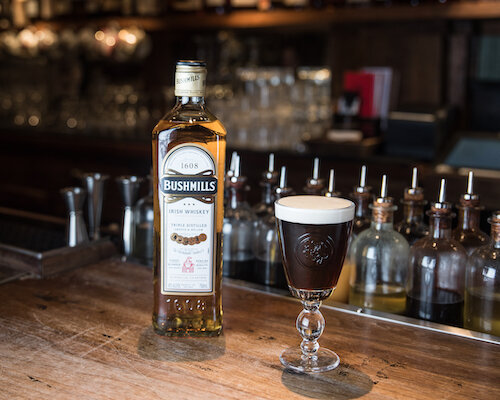6 Reasons a Bartender's Irish Coffee is Better Than Yours
Buena Vista Irish Coffee photo by Sarah Power on Unsplash
St. Patrick’s Day or not, an Irish Coffee is an ideal fall and winter cocktail thanks to its warming nature—both from the hot coffee and the toasty whiskey, while the cream ensures a velvety richness. The cocktail has a fascinating history spanning continents. It was invented in Ireland in 1943, popularized in San Francisco in the 1950s, and then became ubiquitous throughout the U.S., Ireland, and the world.
Irish Coffee History
Joe Sheridan first had the idea to combine hot coffee, Irish whiskey, and cream at Foynes Airport in Shannon, Ireland, to help passengers keep warm. Sheridan is said to have described the recipe thusly: “Cream as rich as an Irish brogue, coffee as strong as a friendly hand, sugar as sweet as the tongue of a rogue, and whiskey as smooth as the wit of the land.”
The drink remained an airport specialty in Ireland until 1952 when travel writer and San Francisco Chronicle columnist Stanton Delaplane tried it on a visit to the Emerald Isle. He returned to the U.S. and asked his friend Jack Koeppler to help him recreate it. Koeppler owned the Buena Vista Café in San Francisco, a bar with a view of the Golden Gate Bridge. The two set to work, eventually perfecting the recipe and method. Koeppler put it on his menu on November 10, 1952, and the drink caught on quickly.
“They benefited from all this press because Stan was putting it in the Chronicle all the time,” says Duggan McDonell, author of Drinking the Devil’s Acre: A Love Letter from San Francisco and Her Cocktails. And, the Buena Vista’s location by the bridge also helped popularize the drink. “Imagine the fog coming in, and there’s the bridge in the background. And you have this piping hot cocktail—and it’s stiff. And it’s sweet and bracing. It’s just perfect for the experience,” says McDonell. “At the time, it had to feel like the quintessential drink to have in San Francisco.”
Soon, people came from far and wide to try the Buena Vista’s Irish coffee and according to McDonell, the bar is the largest buyer of Irish whiskey in the world. The café typically serves more than 2,000 Irish coffees a day. While the ingredients are simple—hot coffee, sugar, Irish whiskey, and cream—it’s easy to mess it up. So what’s the secret to making one of the best hot cocktails? We talked to a few bartenders to find out.
1. Determine which flavors and characteristics you want to highlight.
With just four components, each one matters immensely. And there are dozens of varieties of Irish whiskies and coffee beans, each with its own characteristics. Chris Hennessey of the Dylan Whiskey Bar in Kilkenny, Ireland, suggests deciding what you want your finished drink to taste like and considering how the ingredients will pair. “By dissecting an Irish coffee into sections, we can look at the whiskey or coffee profiles and pinpoint what characteristics we wish to highlight,” says Hennessey. “Coffee can go from floral to nutty to dark roasts and ripe berries and Irish whiskey comes in many forms and character, including grains, malts, pot still, blends, and peat influence.” He prefers using Two Stacks Irish Whiskey paired with a French roast. “With Two Stacks Irish Whiskey, the 8 percent sherry cask pot still alongside 2 percent peated malt pair beautifully with a dark French roast,” he explains. “It complements the oils brought to the surface of the bean and giving a roasted, smoky flavor to the coffee itself, contrasted by the sherry to brighten the ripe berry aspects of the bean.” Jesse Peterson of Morning Glory in San Diego likes Proper No.Twelve whiskey because of its caramel notes that complement the cream float. Kyle Kelley of Bia, an Irish restaurant and bar in Rhinebeck, NY, uses Kilbeggan single grain whiskey because it stands up to the rest of the drink.
2. Use quality ingredients.
This may seem obvious, but in such a simple cocktail with so few ingredients, it pays to use good ones. “You could put the most delicious whiskey on the planet in an Irish coffee...but if the coffee you’re using is terrible there is no coming back from it,” says Alex Fletcher, Beverage Director of Hospitality Alliance (whose portfolio includes the Hard Shake) in Dallas, Texas. Kelley agrees, noting that the coffee should be freshly made. “At Bia, we use a freshly ground and pulled double shot of espresso from a professional machine, which is diluted with a small amount of recently boiled water when the drink is assembled,” he says. “If you’re at home and without an espresso machine, the best method is to make a pour-over coffee, brewed stronger and with slightly more grounds than you would normally use.”
And while it may seem like one of the ingredients with the least amount of decision-making, even the sugar matters. Raw sugar or diluted in a syrup? Brown, white, muscovado, turbinado, or demerara? While the Buena Vista recipe uses sugar cubes, Hennessey prefers syrup, because it “produces a more malleable, consistent ingredient,” and his sugar of choice is muscovado. Peterson uses a brown sugar syrup in hers and Kelley prefers a demerara syrup with a 2:1 sugar to water ratio that he says lends a “velvety viscosity.” And of course, using the freshest cream available will elevate the cocktail immediately.
3. It’s all about balance and the right ratio.
The Dead Rabbit Irish Coffee Bushmills at Bar
New York City’s Dead Rabbit bar has become known for its Irish coffee (which you can now recreate at home with their new kit) and Beverage Director Jillian Vose says balance is key in creating the drink. “When an Irish coffee is done right, it’s a blissful balance of hot and cold and bitter and sweet, with no one element outshining another.” And like most cocktails, ratio matters: Too much whiskey and the coffee’s bold richness is lost. Too little and you can’t taste it all. And an overload of cream can quickly overwhelm. “A big difference between terrible Irish coffee and delicious Irish coffee is the ratio of the ingredients,” says Vose. “The Dead Rabbit’s current recipe calls for only an ounce of Bushmills Original Irish Whiskey. Contrary to popular belief, the drink shouldn’t be too boozy. You want the whiskey to be balanced by the coffee and sweetness and not overwhelm the drinker.” Peterson agrees, recalling that it took a lot of trial and error to perfect her version of the drink. “The answer lies within the ratio. That first sip is delightful, and the whiskey shines but doesn’t punch. The balance between just enough whiskey and just strong enough, good coffee without too much coffee—a little sweet but not too sweet—and the cream layer lying on the top like a secret trap door waiting to be opened.”
4. Make sure your cream is the right consistency.
Supposedly, Deleplane and Koeppler had trouble making the cream float on top of the coffee at first, until they used fresh cream whipped to the right consistency. The trick is to not let the cream overpower the drink, says Vose. “I personally love when an Irish coffee has the right consistency of cream on top—it’s thick enough to sit on top of the liquid, but not so thick it’s hard to drink.” Kelley agrees: “You want the cream to thicken enough to be luxurious and float on top of the drink, but not so much that it becomes like whipped cream you would see on a slice of pie.” At Bia, they pour fresh cream into a plastic squeeze bottle with a coiled-up wire strainer inside. They shake it for about 45 seconds to achieve a sort of half-whipped texture.
5. If you must tweak, do it carefully.
While the original Irish coffee calls for four ingredients, sometimes you may want to add your own spin. Just do it carefully. A glug of Irish cream can go a long way. Peterson likes to add a pinch of salt to her whipped cream. Kelley garnishes with freshly ground nutmeg atop the cream. Fletcher suggests considering things that will complement the other ingredients. “Try zesting orange oils for a citrus note or adding cinnamon to the cream before whipping—both of these will normally complement coffee flavorings,” he says. “Almond or banana flavoring in the cream will complement most Irish whiskeys.”
6. Use the right glass, and preheat it.
The Irish coffee is one of those cocktails that has its own glass. It’s thin, stemmed glass, with a small handle and tulip opening. McDonell suspects the tulip top helps integrate the ingredients. “It holds the cream better, and so every time you take a sip, it naturally integrates the whiskey-sugar-coffee experience with that of the heavy cream on top.” Kelley says the glass has two advantages: “Thin glass lets it preheat more efficiently and make the overall drink hotter than a thick mug would, and the visual appeal of seeing the layered cream through a transparent glass is essential to the experience.” He adds that preheating the glass with boiling water is a must and recommends leaving the hot water in the glass until right before you start building the cocktail.
Irish Coffee
Recipe courtesy of Chris Hennessey
40ml Two Stacks Irish Whiskey
10ml Muscovado syrup - 2:1
120ml French roast
30ml freshly light whipped cream
Freshly grated nutmeg in the center of the cream.



